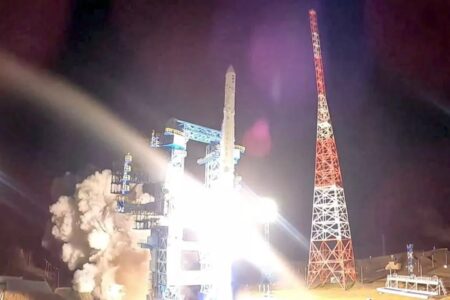On October 15, 2022, at 22:55 Moscow time, the Russian Aerospace Forces successfully launched a light-class carrier rocket Angara-1.2 with a spacecraft from the State Test Cosmodrome of the Ministry of Defense of the Russian Federation in Plesetsk in the Arkhangelsk Region.
The launch of the spacecraft into the planed operational orbit was carried out according to the plan. Two minutes after the launch, the carrier rocket Angara-1.2 was tracked by ground control facilities of the Titov Main Test and Space Systems Control Centre.
At the estimated time, the spacecraft was launched into the final transfer orbit and went under the control of the ground facilities of the Russian Ministry of Defense. The spacecraft was assigned the serial number Cosmos-2560.
Stable telemetry communication has been established and maintained with the spacecraft, its onboard systems are functioning normally.
After the spacecraft was put into orbit, the officers of the Main Centre for Reconnaissance of Situation in Space of the Space Forces of the Aerospace Forces included it into the Main Catalog of Space Objects of the Russian Space Control System and began analyzing and processing information about it.
This is the second launch of the new Russian light carrier rocket Angara-1.2 in serial version (rocket No. 2L), the main developer of which is the Khrunichev State Research and Production Space Center which in turn is part of the State Space Corporation Roscosmos. The first launch of the Angara-1.2 launch vehicle of the Angara family in serial execution (No. 1L, No. 71602) took place on April 29, 2022.
Angara-1.2 is a three-stage rocket which includes the universal rocket module URM-1 of the Angara family with the RD-191 engine as the first stage, a specially designed second stage of a diameter of 2.9 m with the RD-0124A engine and a detachable service module AM equipped with four small 11D458 engines with 40 kgf thrust and 14 17D58E engines with 1.3 kgf thrust as the third stage. The length of Angara-1. in the serial version is about 41.5 m, the launch mass is about 171 tons, the payload capacity is up to 3800 kg when launched into a low reference orbit with a height of about 200 km.
According to open sources, on October 15, the Angara-1.2 launched the third small-sized optical reconnaissance satellite of the new generation MKA-R of the Razbeg series developed by All-Russian Scientific Research Institute Of Electromechanics (VNIIEM) under the designation Cosmos-2560. The reliability of this information and identification is unknown. A number of sources reported that the mass of the satellite is 150 kg. The Cosmos-2560 satellite orbits at a height of 335 x 353 km with a period of 91 minutes. Presumably, the satellites of the Razbeg series are equipped with a digital camera developed by Peleng (Belarus), which has a maximum resolution of 0.9 meters in panchromatic mode.
If the data on the identification of Cosmos-2560 as MKA-R is correct, then this is the third launched satellite of this type after the first two that turned out to be inoperable.
Recall that, as it is believed, the launch of the first Razbeg satellite under the designation Cosmos-2551 was carried out by the Soyuz-2.1V carrier rocket from Plesetsk on September 9, 2021, but it turned out to be unsuccessful. The device did not function from the moment it entered orbit and on October 20, 2021 burned down in dense layers of the atmosphere. The launch of the second satellite of the Razbeg series, apparently, was carried out under the designation Cosmos-2555 during the first launch of the Angara-1.2 launch vehicle on April 29, 2022, but the device began to decline from the moment it was put into orbit and also burned down in dense layers of the atmosphere on May 18, 2022.







I wonder if this rocket is carrying some kind of space shotgun that might take out lots of hostile satellites on low earth orbit.
Nah, it’s a recon satellite. Russia certainly needs more of these.
“Presumably, the satellites of the Razbeg series are equipped with a digital camera developed by Peleng (Belarus), which has a maximum resolution of 0.9 meters in panchromatic mode.” It is reconnaissance satellite, too light to have weapons.
With all those failures going down in russian aerospace appears they might be also suffering with the affirmative-action plague
NATO is making its last stand!
The Beast with Seven Heads and Ten Horns with the Prostitute riding on the Beast is coming to an end.
NATO loses in a horrible fashion.
My condolences to NATO….. you were and still are a relic of the past
When i read “went according to plan” i do not get a good feeling…
Russia is testing: the previous launches may have been targeted by the criminal powers and thus failed due to such actions. If it happens this time it’s game over and all enemy satellites will be fair game.
This is a moment in world history which will determine the fate of humanity versus the satanist cabal.
russian artillary with drones from ebay are wrecking nazi and dumbfuk nato merc quite efficiently as is. altho those himar becoming a bit of an annoying bung hole itch… especially for civilians.
maybe well see all the himar get wiped out next week with this new thermal sat.